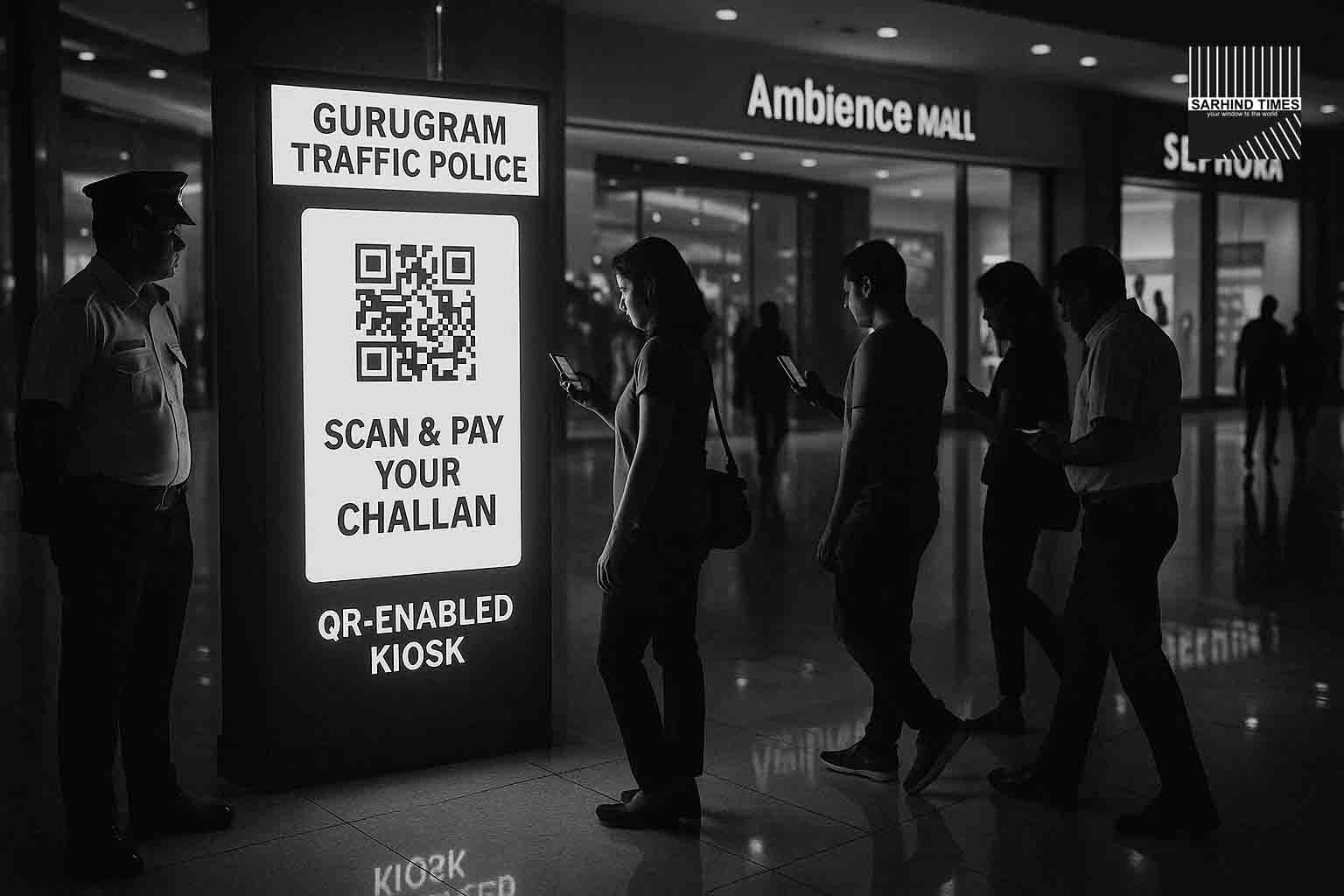In a first-of-its-kind move, Gurugram Police has introduced a self-service QR kiosk that allows motorists to check and clear pending challans within minutes—ushering in a new era of digital convenience for urban enforcement.
Residents in Gurugram can now instantly view and pay traffic fines at a newly launched QR-enabled kiosk inside Ambience Mall. The system—unveiled by DCP (Traffic) Dr. Rajesh Mohan—marks India’s first public QR kiosk for traffic challans. The initiative aims to simplify fine payments, reduce queues, and support cashless enforcement. If successful, similar kiosks will be installed at key city junctions and malls in the coming months.
🚦 Gurugram, October 13 — Traffic Gets a Digital Makeover
In a city known for its fast-moving cars and ever-busier intersections, paying a traffic challan just got a lot simpler.
The Gurugram Police, continuing its series of digital initiatives, has launched India’s first QR-based self-service kiosk for instant payment of traffic fines—bringing together convenience, technology, and transparency in one smart terminal.
Installed at Ambience Mall, near the Delhi-Gurugram border, the kiosk was inaugurated this week by DCP (Traffic) Dr. Rajesh Mohan, who hailed it as a step toward “frictionless citizen services and paperless enforcement.”
“This initiative reflects Gurugram’s commitment to combining technology with public convenience,”
— said Dr. Rajesh Mohan, during the launch event.
“Our goal is to ensure that no citizen has to wait in queues or visit offices for something that can be done in seconds.”
💡 How It Works: Scan, Check, and Pay
The process is simple and entirely digital:
- Motorists approach the kiosk and scan their vehicle number or driver’s license QR code using the on-screen interface.
- The system instantly displays all pending challans, including location, date, and violation type.
- Users can then select the challan(s) they wish to pay and choose from UPI, debit/credit card, or wallet options.
- Once payment is confirmed, a digital receipt is generated and sent to the user’s registered mobile number.
The kiosk connects directly to the Haryana Traffic Police eChallan system, ensuring real-time verification and preventing duplicate or fraudulent payments.
🏙️ Why Gurugram First?
Gurugram’s traffic dynamics—marked by high vehicle density, rapid urban expansion, and proximity to Delhi—make it an ideal testing ground for smart enforcement models.
With over 18 lakh registered vehicles and daily cross-border traffic of nearly 7 lakh commuters, the city experiences both urban congestion and digital readiness, a rare combination that supports technology-first governance.
“Gurugram is a Smart City not just in name but in implementation,”
— said Joint Commissioner of Police (Traffic) in a media statement.
“Digital enforcement is the future, and citizen-friendly models like kiosks make compliance easier rather than punitive.”
The Ambience Mall location was chosen for its high footfall (approx. 80,000 visitors on weekends) and ample parking facilities, allowing the public to test and use the system without disrupting daily movement.
📱 The QR Revolution: From Roads to Retail
The kiosk reflects a larger transformation sweeping India’s urban ecosystems — the rise of QR-based payments.
Following the exponential growth of UPI transactions (12.2 billion in September 2025), government departments are increasingly integrating the same backbone for public services.
From metro ticketing and toll plazas to municipal water bills, QR codes are becoming the universal gateway of governance.
The Gurugram Traffic Department’s move symbolizes how citizen interfaces are converging into seamless payment experiences — bridging the gap between government services and digital literacy.
“We’re meeting citizens where they already are — on their smartphones,”
— said ACP (Traffic South).
“If paying for coffee can happen in two taps, why not a challan?”
🧾 Transparency and Traceability
Traditional challan payments often required visits to physical offices or manual entries at cash counters, leading to inefficiencies and, in some cases, disputes.
With QR-based kiosks, every transaction leaves a digital audit trail, increasing transparency, speed, and accountability.
The backend integration with Haryana’s Parivahan Sewa portal ensures all payments reflect in the system within seconds — a critical step that also updates insurance and registration databases automatically.
Officials say this approach will help:
- Reduce pending challans and manual data errors.
- Discourage intermediaries or touts.
- Build public trust through self-service convenience.
“Digital traceability means fewer disputes and faster enforcement cycles,”
— noted Traffic Tech Officer Manoj Kumar, part of the project’s implementation team.
🧩 Pilot Model: Scalable and Replicable
While the Ambience Mall kiosk is a pilot, plans are already underway to replicate the model across Gurugram.
Proposed next locations include:
- MG Road Metro Station
- CyberHub
- Ardee City Market
- Sadar Bazar Parking Zone
Authorities estimate that 10–12 kiosks could be operational by early 2026, each capable of processing 300–500 payments per day.
Integration with other municipal fines — such as parking or sanitation penalties — is also on the roadmap.
“The goal is to make Gurugram a 100% digital enforcement zone,”
— said DCP (Traffic) Dr. Mohan,
“so that compliance feels empowering, not punitive.”
🌐 The Smart-City Perspective
The kiosk rollout aligns with Gurugram’s Smart City 2.0 Vision, which prioritizes mobility, e-governance, and sustainability.
Other initiatives under the umbrella include:
- AI-based traffic signal management at 18 key junctions.
- Drone-assisted congestion monitoring near toll plazas.
- License plate recognition (ANPR) cameras to track violators.
- Digitized towing operations with live dashboards.
Together, these create a data-driven enforcement ecosystem, where citizen behavior and traffic patterns inform long-term planning rather than just penalization.
“Data is the new road map,”
— remarked a Smart City official.
“We’re not just building roads anymore — we’re building responsive systems.”
💳 Why Digital Payment of Fines Matters
Digitization of fines is not merely about convenience — it’s about financial discipline and civic trust.
India’s traffic systems historically faced bottlenecks in collection, reconciliation, and compliance.
Digital solutions bring four key benefits:
- Frictionless Compliance: Citizens can pay instantly, avoiding late fees.
- Revenue Efficiency: Funds are transferred directly to government accounts.
- Reduced Corruption: Eliminates middlemen and paper handling.
- Behavioral Shift: Promotes awareness and accountability among motorists.
According to the Haryana Police’s 2024 report, digital payments already account for 74% of all challan settlements in the state.
With kiosks, officials expect that number to cross 90% by next fiscal year.
🎯 Challenges: Adoption and Maintenance
Experts, however, caution that success depends on user education and infrastructure upkeep.
Digital kiosks often face downtime due to poor internet connectivity or vandalism in public spaces.
Authorities are therefore pairing the rollout with on-site assistance staff, at least in the pilot phase, and public awareness drives through FM radio, RWAs, and social media.
“Technology only works when people trust it,”
— said Rajiv Sharma, former Gurgaon Traffic Advisory Council member.
“Citizens must feel confident that their digital payment is instant, secure, and final.”
Cybersecurity audits will also be conducted regularly to prevent QR spoofing or phishing risks, officials confirmed.
📊 Citizens React: “About Time!”
The public reception has been overwhelmingly positive.
Commuters interviewed at Ambience Mall described the system as “fast,” “intuitive,” and “long overdue.”
“I checked and cleared two challans while waiting for my family at the food court,”
— said Puneet Arora, a resident of DLF Phase 3.
“It’s exactly what a Smart City should feel like.”
Mall authorities also see the kiosk as a crowd-service attraction, combining convenience with civic responsibility.
“People can shop, dine, and clear fines — all under one roof,”
— joked a mall manager.
📍 Festive-Season Context: Part of a Larger Traffic Plan
The kiosk’s introduction coincides with Gurugram Police’s “Smooth Festive Transit 2025” campaign — a citywide effort to manage traffic congestion during the Diwali shopping surge.
Key components of the plan include:
- Deploying extra marshals near U-turn bottlenecks.
- Setting up mobile traffic command units.
- Using AI cameras to flag no-parking violations in real time.
The QR kiosk complements these measures by freeing up personnel from manual challan processing — allowing redeployment toward on-ground traffic regulation.
🏗️ Future Integrations: From Traffic to Transit
Officials envision expanding the kiosk’s functions to include:
- Metro smart-card recharge.
- Public parking payments.
- Vehicle tax renewals.
- Real-time feedback modules for road-safety suggestions.
In collaboration with the National Informatics Centre (NIC) and PayGov India, the kiosks could evolve into multi-utility citizen service stations for all transport-related payments.
💬 Policy Angle: Towards a Paperless Enforcement Regime
Haryana’s Transport Department has been gradually phasing out manual challans since 2020.
Gurugram’s latest innovation is therefore not an isolated experiment but part of a broader digital roadmap supported by the Ministry of Road Transport and Highways (MoRTH).
The Digital India Mission envisions such models as templates for replication nationwide — from urban metros to Tier-2 cities.
“It’s not just about digitizing fines — it’s about democratizing access to governance,”
— said a senior official from NITI Aayog’s transport innovation cell.
If the model succeeds, it could become the blueprint for a national rollout, integrated with e-governance dashboards.
🌏 Global Inspiration
Similar self-service kiosks exist in countries like Singapore, Dubai, and Seoul, where traffic fine payments are automated through smart terminals at malls and metro stations.
Gurugram’s adoption of a comparable system signals India’s growing alignment with global urban-tech standards, while still tailoring the solution to local realities like UPI usage and mobile-first payments.
“We’ve leapfrogged older systems,”
— noted a MeitY innovation consultant.
“India didn’t follow the West — we built our own QR-powered path.”
🔚 Conclusion: A Small Kiosk, A Big Leap
The QR-based traffic-fine kiosk may appear like a small addition to Gurugram’s mallscape, but its implications reach far beyond — symbolizing the fusion of convenience, compliance, and civic innovation.
By merging fintech simplicity with governance transparency, Gurugram has taken a tangible step toward citizen-centered policing.
As other cities watch closely, one message stands clear:
smart cities aren’t built by infrastructure alone—they’re built by inclusion, innovation, and intelligent ideas.
“The future of traffic management is not punitive, it’s participatory,”
— concluded DCP Dr. Mohan at the ceremony.
“And this kiosk is a symbol of that partnership.”
#Gurugram #TrafficPolice #DigitalPayments #UPI #SmartCity #Challan #Innovation #SarhindTimes























+ There are no comments
Add yours